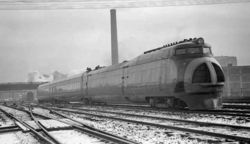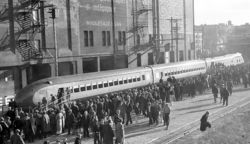M-10000

The Union Pacific Railroad's M-10000, completed in February 1934, was the first internal combustion engined, lightweight streamliner train in the United States. The carbodies and interior fittings were built by Pullman-Standard while the engines, mechanical and electrical components were from General Motors' Electro-Motive Division.
Styling featured a turret cab, an inward-slanting aluminum body with a nose form of parabolic arches, with a large nose air intake. The train was painted in Armour Yellow with Leaf Brown roof and undersides; later, the area around the front air intake was also painted yellow. Dividing lines of red were painted to separate the colors.
The train was fully articulated—trucks were shared between adjacent cars. There were three cars in total; a driving, power and baggage car at the front, and two passenger cars. Subsequent streamliners would be diesel powered, but a reliable engine of sufficient power-to-weight ratio was not available for the M-10000 and it was delivered instead with a spark-ignition 191-A gasoline engine. The first truck bore traction motors and was the only one powered.
The M-10000 was as much a publicity tool as a practical train; it was exhibited all over UP's territory, attracting crowds and much press attention, and succeeded in its aim of helping reinvent and modernise the passenger train in the popular imagination. Streamliners inspired by the M-10000 were rapidly developed, and before long most railroads had a "streamlined" train of some form or other.
The M-10000 was eventually named City of Salina for the train it served, but it was also nicknamed the "Tin Worm".
Union Pacific's M-10000, since it was built of aluminum, was scrapped in 1942 for the war effort, among other reasons.
The paint scheme devised for the M-10000 is still in use today, except that the brown sections were later changed to gray.
See also
Limited production and export locomotives built by EMD | |
|---|---|
| Electrics | SW1200MG · AEM-7 · GM6 · GM10 · GF6C |
| Industrial, military, export and narrow gauge | Model 40 · DDM45 · DHI · GMDH-1 · GMDH-3 · MRS-1 · GA8 · G8 · G12 · G16 · G26 · NF110 · NF210 · JT42CWR (Series 66) · JT42HW-HS · GT46MAC · GT22HW · GT46PAC |
| Streamliners | M-10000 · M-10001 · M-10002 · M-10003-6 · Pioneer Zephyr · General Pershing Zephyr · Green Diamond · Flying Yankee · Aerotrain |
| Experimentals | 1800 hp B-B |
| See also: List of EMD locomotives | |

